
The COMSOL Conference 2023 returned in person this year in Munich, Germany, where the multiphysics simulation community formed new connections, learned about the latest advancements in the COMSOL Multiphysics® software, and drew inspiration from each other’s innovative work. During the three-day event, engineers, researchers, and scientists across industries showcased their findings through poster and slideshow presentations. Six teams earned special recognition for their work, receiving Best Paper and Best Poster awards.
200+ Presentations Showcasing a Wide Range of Simulation Use Cases
The 150 posters and 50+ papers featured at the COMSOL Conference 2023 Munich covered a wide range of topics, including heat transfer and phase change; batteries, fuel cells, and electrochemical processes; bioscience and bioengineering; renewable energies; and much more. The dedicated conference program committee consisting of 48 members from different industries and research institutions carefully reviewed and evaluated the abstracts that were submitted and decided which ones to approve. They also selected the three top papers to win the Best Paper awards. We are grateful for the program committee members’ diligent efforts!
During the live event, presenters showcased their posters and discussed their work in detail, leading to in-depth discussions and feedback. After looking through the poster hall, conference attendees voted for their favorite posters to crown the three Best Poster award winners. Those who submitted full-length papers will continue to receive recognition long after the event through the Technical Papers and Presentations gallery, which is now live.
Left: One of the two poster halls. Right: Two of the Best Poster awards.
Without any further ado, let’s see who took home awards for their work at the COMSOL Conference 2023 Munich.
Top 3 Papers
Electrochemical Deposition for PCB Applications
The first of the Best Paper award winners were Sascha Loebel of Chemnitz University of Technology and fellow researchers S. Braun of Fraunhofer ENAS; M. Becker of NB Technologies Gmbh; and P. Steinert and A. Schubert, both of the Chemnitz University of Technology, for their paper titled “Modeling Electrochemical Deposition of Aluminum from Ionic Liquids for PCB Applications”.
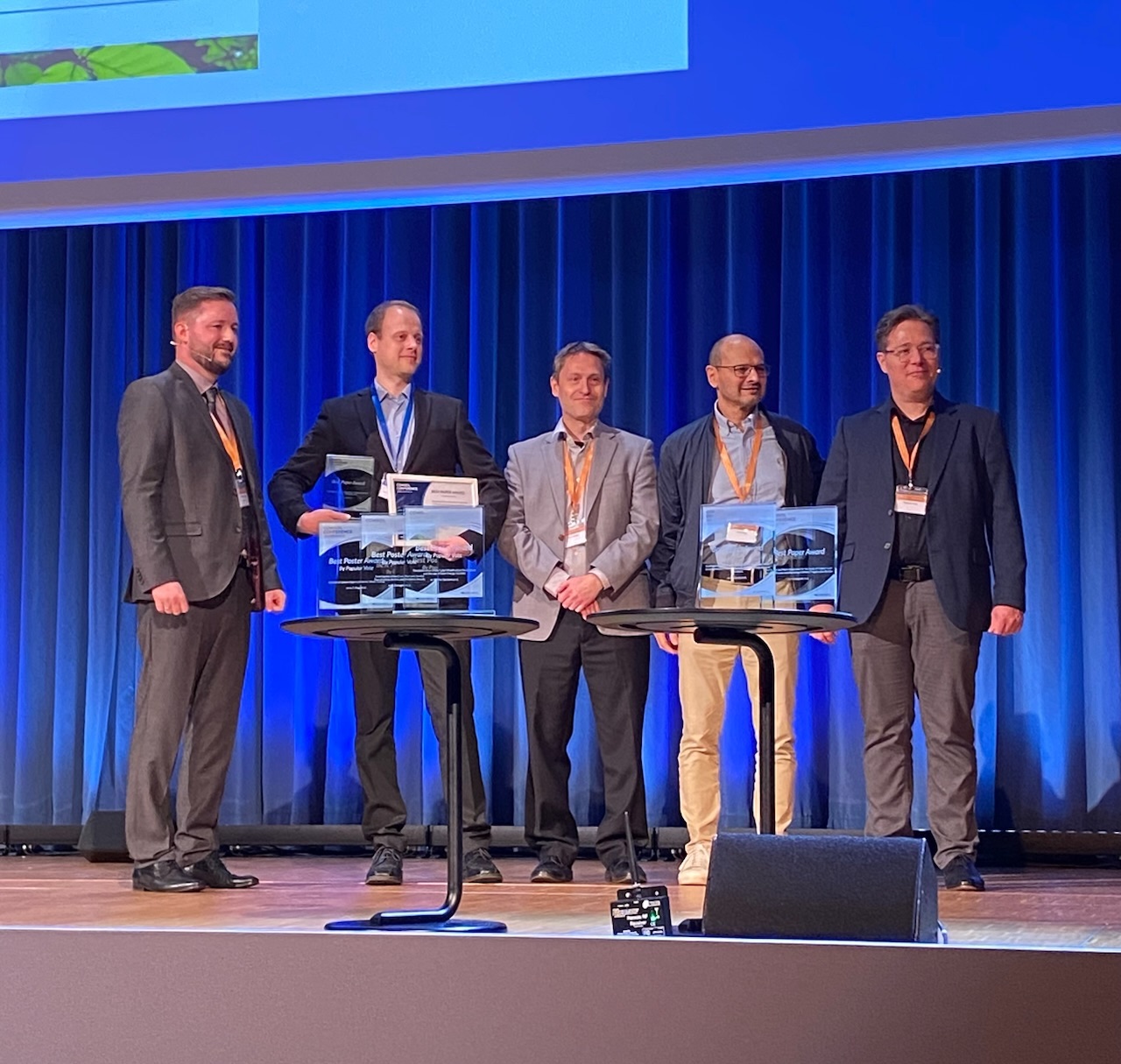
Sascha Loebel of TU Chemnitz being presented with the first Best Paper award. From left to right: Phillip Oberdorfer of COMSOL, Sascha Loebel of TU Chemnitz, and Bjorn Sjodin, Ed Fontes, and Thorsten Koch of COMSOL.
In the paper, they showcase how they modeled the electrochemical deposition of aluminum from an ionic liquid electrolyte on a PCB substrate. In the first part of their two-stage modeling approach, fluid dynamics within a process chamber were characterized using a macroscale model based on CAD data. In the second stage, the results from the first model were implemented in a microscale model for calculating electrolyte flow and ion transport in the vicinity of a vertical interconnect access (via) that needed coating. By linking these two models, they were able to consider the fluid dynamic conditions within a process chamber and compare their results to similar experimental investigations.
Left: The macroscale model, which shows electrolyte flow characteristics (green arrows) and the pressure distribution caused by substrate movement (red arrow) in the process chamber. Right: The microscale model showing the concentration of aluminum species and electrolyte flow.
Measuring Energy Efficiency of Quay Walls
The development of energy geostructures is an innovative way to help reduce our reliance on fossil fuels. These structures can supply mechanical support to overlying structures and/or soil as well as geothermal energy for space heating and cooling. Despite their promising features, the thermal and thermomechanical behavior of geostructures is not well understood.
As a way to gain more understanding, Marco Gerola of the University of Milan, F. Cecinato of the University of Milan, J.K. Hassnoot of CRUX Engineering BV, and P.J. Vardon of Delft University of Technology turned to multiphysics modeling. This team developed models that helped them gain an in-depth understanding of these geostructures and allowed them to identify the parameters that have the greatest impact on energy extraction. They were recognized with a Best Paper award for their comprehensive explanation of their work in the paper “Understanding the Thermal Efficiency of Energy Quay Walls: A Comprehensive Study Using Field Tests and Finite Element Simulations”.
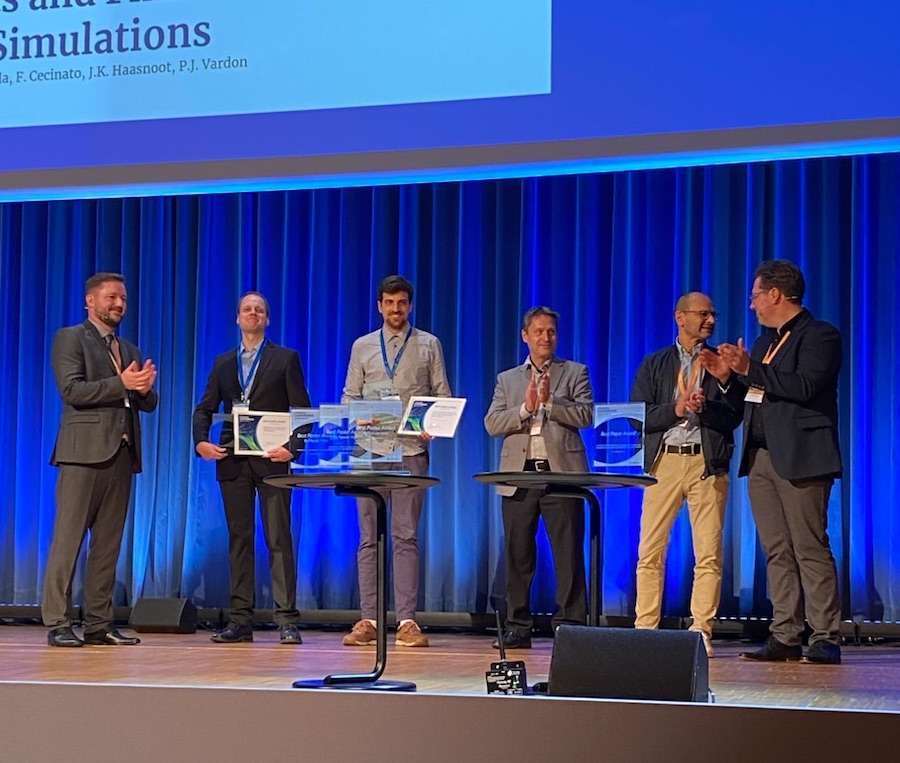
Marco Gerola of the Università di Milano being presented with a Best Paper award. From left to right: Phillip Oberdorfer, Sascha Loebel, Marco Gerola, Bjorn Sjodin, Ed Fontes, and Thorsten Koch.
Copper Laser Welding Process Stability
The final Best Paper award went to Julien Daligault, M. Dal, and S. Touzouirt of ENSAM and M. Sawannia, C. Hagenlocher, and R. Weber of the University of Stuttgart for their paper “Ray Optics and Mesh Adaption for the Study of Copper Laser Welding Process Stability Using COMSOL® Application Builder”.
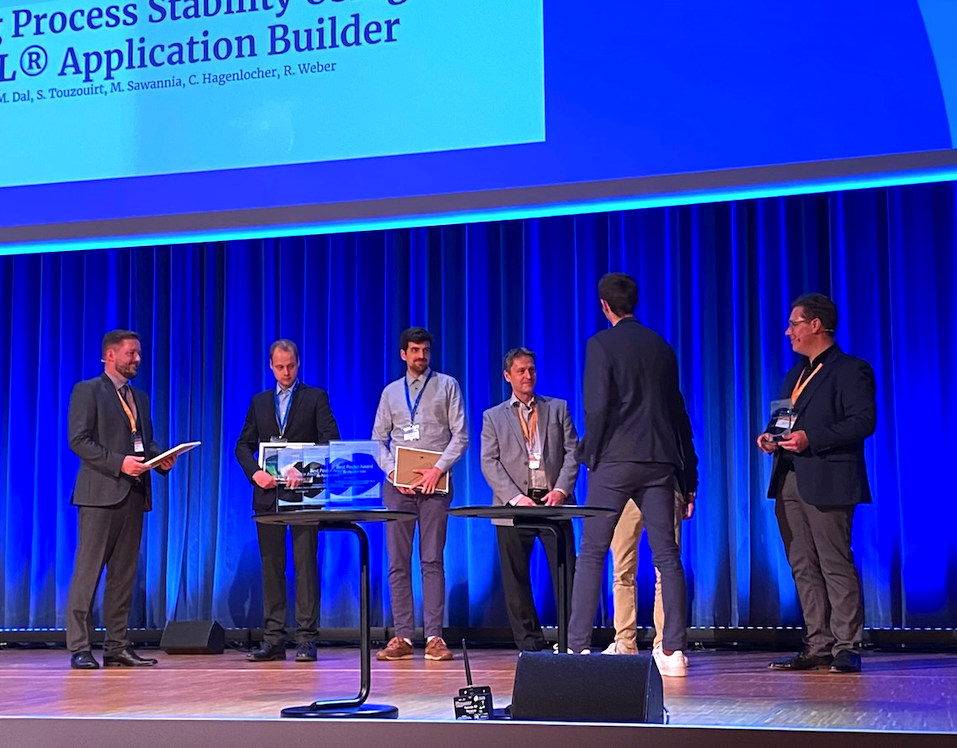
Julien Daligault of ENSAM walking onto the stage to receive the final Best Paper award.
Their paper focused on the use of multiphysics simulation for analyzing copper laser welding. Although the process is well understood for materials such as steel or titanium alloys, this is less true for the study of highly reflective and thermally conductive materials like aluminum or copper. The team developed a numerical model to understand the complex physical phenomena that occur during this type of laser welding.
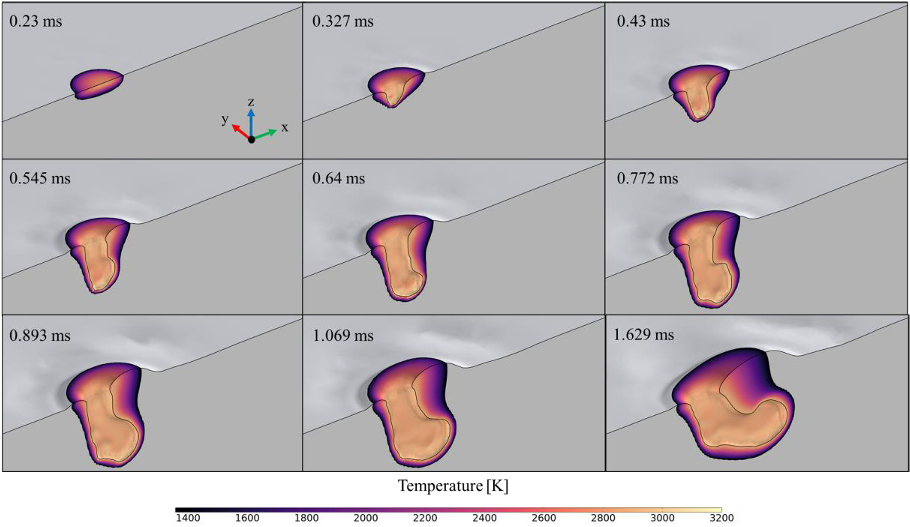
Their model showing the evolution of the molten pool during copper laser welding.
Top 3 Posters
Simulating Under-Lake Infrastructure
The first of the three Best Poster winners were William van Sprolant of CvS Energies Sàrl and Daniel Bello-Mendes and Roland Rozsnyo of HEPIA for their poster on the hydrothermal potential of lakes. The poster showcases the team’s work within the ULISSE project, which focuses on developing an underwater tank that can store thermal energy from the surface of lakes and restitute it during the cold season. Before creating a full-sized tank, the team developed a small-scale mock-up and used the COMSOL Multiphysics® software to better understand the behavior of the system. Their model was in agreement with their physical tests results and its theoretical model calculation.
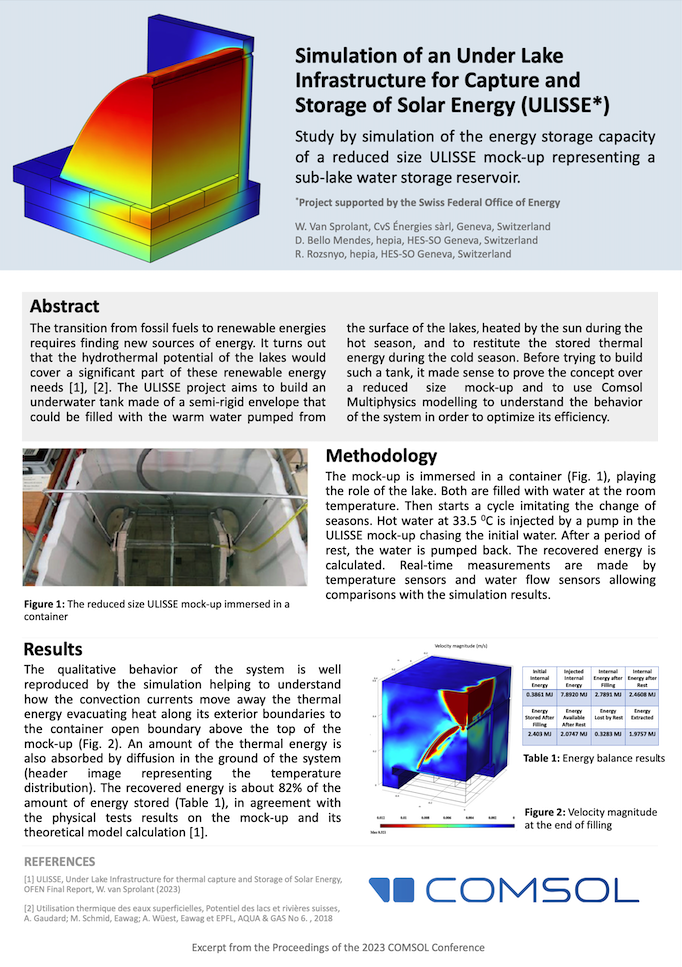
The first Best Poster award winner, featuring the mock-up and model the team developed.
Investigating Crystalline Lens Inertial Overshooting
The second Best Poster award went to Ali Dahaghin, Milad Salimibani, Agnieszka Boszczyk, Agnieszka Jóźwik, and Damian Siedlecki from the Wroclaw University of Science and Technology for their poster on the investigation of inertial behavior of the crystalline lens. In this work, the team created a 2D model of a porcine eye in order to explore the mechanical responses of a crystalline lens when facing inertial overshooting. The team compared their model’s results with the results of ex vivo experiments, which showed good agreement. The results of both pointed to the importance of the damping system in absorbing forces acting on the lens.
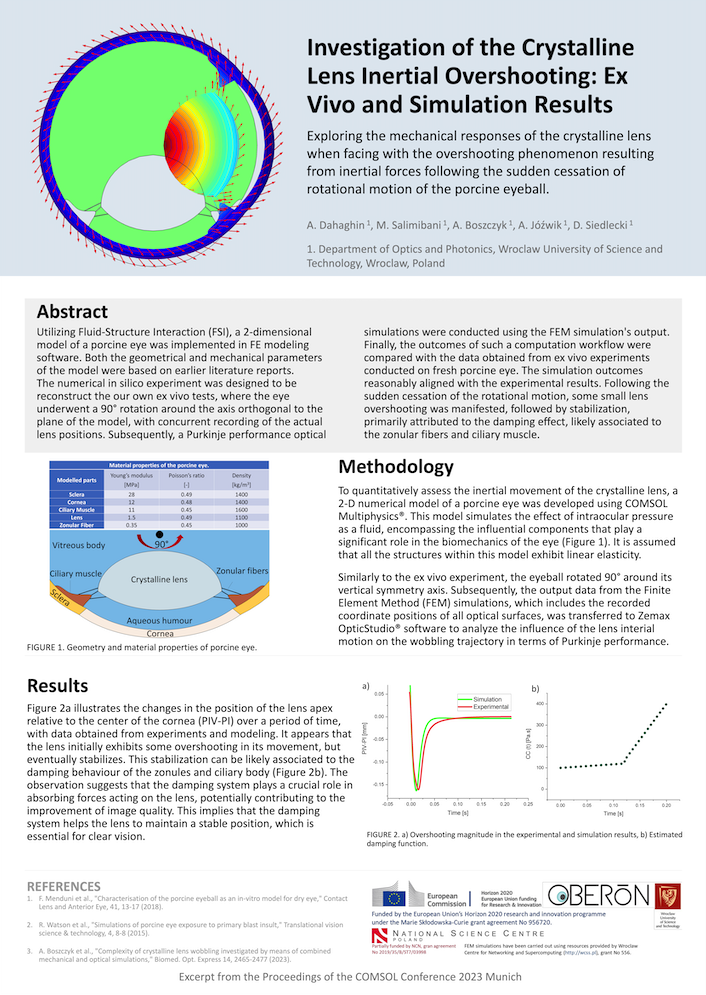
The second award-winning poster, which focuses on crystalline lens inertial overshooting.
Shock Testing a Sphere-Plate Collision
Spacecraft and their onboard equipment are often subject to strong dynamic loads in their missions. Particularly troublesome are severe high-frequency shocks that are typically caused by the activation of pyrotechnic devices. These shocks are transmitted to the entire structure and can be the cause of a failed mission.
Researchers Alessandro Daga, Luca Viale, and Luigi Lentini of the Politecnico di Torino explored this topic in their poster on the analysis of sphere-plate collision for shock testing, which earned them the final Best Poster award. In this work, they used simulation to better understand the contact dynamics of a plate pyroshock testing. They found their results were in line with their reference simulation model and were encouraged that these results could lead to improvements in the shock simulation field.
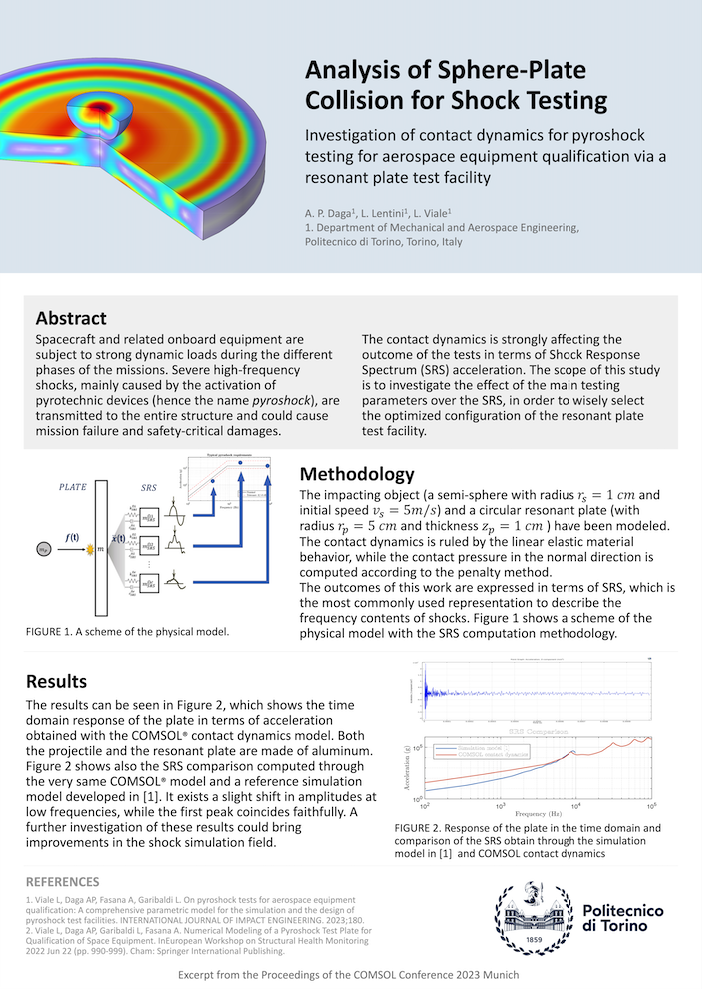
The third Best Poster award winner, this work shows off this team’s analysis of sphere-plate collision.
Congratulations to the Winners
Just like the range of topics that they covered, the award-winning papers and posters came from a range of places around the world, as the winners represented five different countries. We would like to thank all those who attended and presented their research at the COMSOL Conference 2023 Munich and congratulate all of the Best Paper and Best Poster recipients.
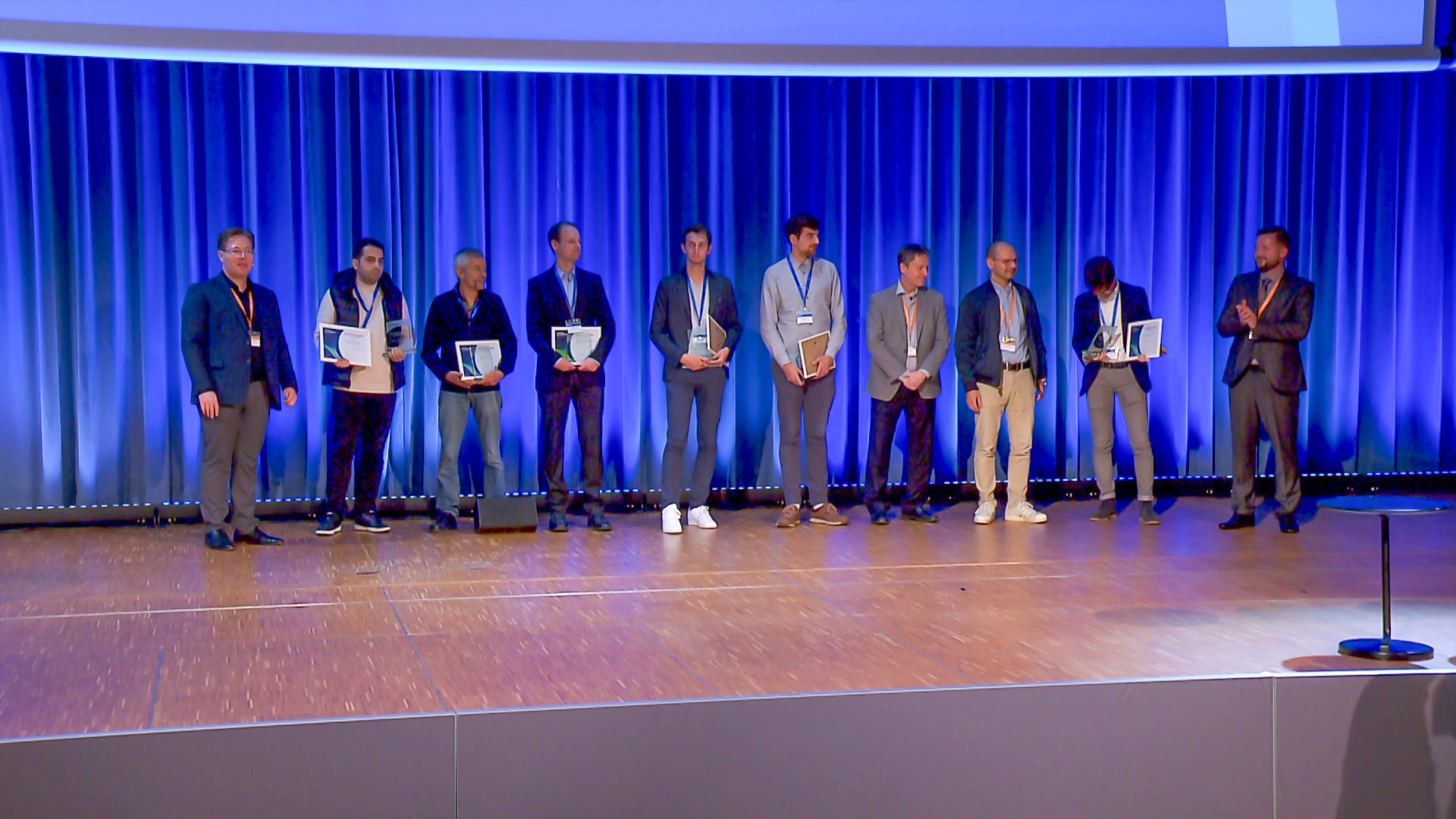
The COMSOL Conference 2023 Munich paper and poster award winners. From left to right: Thorsten Koch of COMSOL, Al Dahaghin of the Wroclaw University of Science and Technology, William van Sprolant of CvS énergies sàrl, Sascha Loebel of TU Chemnitz, Julien Daligault of ENSAM, Marco Gerola of the Università di Milano, Bjorn Sjodin and Ed Fontes of COMSOL, Luca Viale of Politecnico di Torino, and program chair Phillip Oberdorfer.
Next Steps
The COMSOL Conference brings together engineers, researchers, and scientists on the cutting edge of their respective fields and, while we highlighted these six teams, all submissions attained a quality level worthy of recognition. You are welcome to explore all of the other innovative works that were on display at the COMSOL Conference 2023 Munich in our Technical Papers and Presentations gallery.

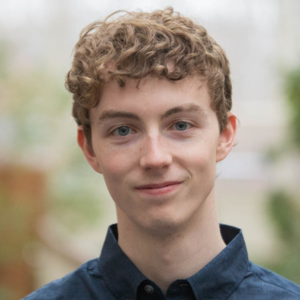



Comments (1)
DIANE HUGHES
February 1, 2024COMSOL is the quintessential presentation of cutting edge of science frequently not available through any other jpurnal or science outlet.